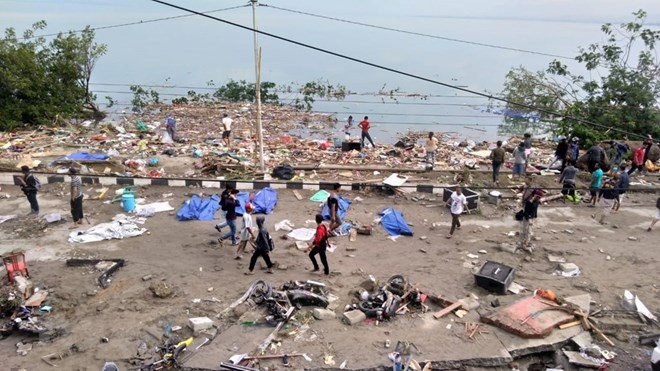Most of the victims are in the centralSulawesi city of Palu, the hardest hit by the tsunami.
According to Reuters, strong aftershockscontinued to rock the coastal city on September 29 morning after waves up tothree metres high swept through the scenic tourist town.
Hundreds of people were preparing for a beachfestival to celebrate Palu's anniversary on September 28 so the death tollwould continue to rise.
Spokesman of the BNPB SutopoPurwo Nugroho said the tsunami destroyed thousands of houses and residentialareas, hospitals, malls, hotels and bridges.
The number of victims in Donggala town, includingcoastal areas near Talisa beach, has been unaccounted as BNPB has yet toreceive any information from the town, which is 27km away from the quake’sepicentre.
Rescuers, police, soldiers and volunteershave worked to evacuate people. Meanwhile, power shortage occurred in manyareas, hindering search and rescue.
After the quakes shook Palu and Donggata,thousands of people had to leave their houses to take shelters in higher placeson September 28 night.
The Indonesian National Search and Rescue Agency (Basarnas) has setup temporary shelters while local people are waiting for aid, especially foodand medicine.
Airplanes carrying necessities were mobilisedto support victims. However, the Mutiara Sis Al Jufri airport in Palu wasclosed and its air traffic control centre was damaged during the disaster,which could pose difficulties in aid and rescue in the coming time. Roadtraffic in east and south areas to Palu were also interrupted.
Medical teams from the Indonesian governmentare on their way to Palu and Donggala of Central Sulawesi while local hospitalsare overloaded.
The same day, United Nations Secretary-GeneralAntonio Guterres expressed his sympathies for the human and property losses caused by the earthquakes and tsunamiand the UN Secretary-General’s Spokesperson Stephane Dujarric said UN officials are ready toprovide support as required.
Suwelasi was ravaged by two quakes of 6.1magnitude and 7.5 magnitude on September 28. A tsunami happened after the second quake hit the area in theafternoon of the same day.
A series of earthquakes in July and Augustkilled nearly 500 people on the holiday island of Lombok, hundreds ofkilometres southwest of Sulawesi.
Indonesia sits on the Pacific Ring of Fireand is regularly hit by earthquakes. In 2004, a big earthquake off the northernIndonesian island of Sumatra triggered a tsunami across the Indian Ocean,killing 220,000 people in 13 countries, including more than 168,000 inIndonesia.-VNA




























